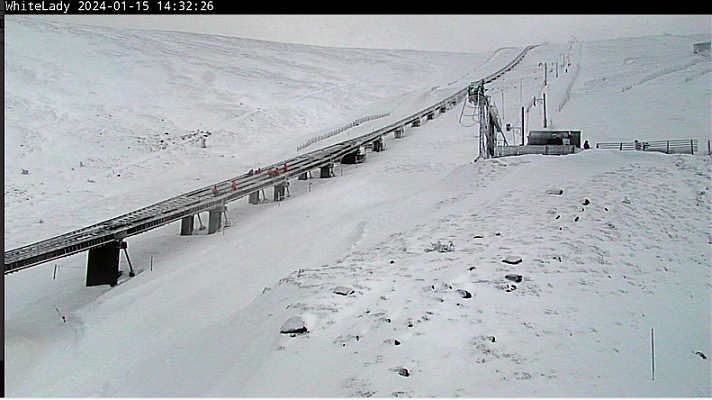
The Cairn Gorm funicular railway first went into service on 24 December 2001. The significant cost overruns have been well documented but it should be made clear that the construction costs were met from the public purse and that there was no requirement on the operating company to repay any of that grant funding. The funicular construction costs were not therefore directly responsible for the financial failure of the operating company in 2008
The company accounts show that the operator had liabilities of £3,176,30 as at 31 March 2002. Despite the fact that passenger numbers were relatively good in the early years of operation, averaging 171,565 between 2002 and 2007 inclusive, this did not lead to a financial success. In fact, net liabilities had risen to £5,264,973 by 31 March 2008. This unsustainable financial position led directly to Highlands and Islands Enterprise acquiring all of the hill business assets on 16 May 2008 which saved the business from liquidation.
Strategic Failures
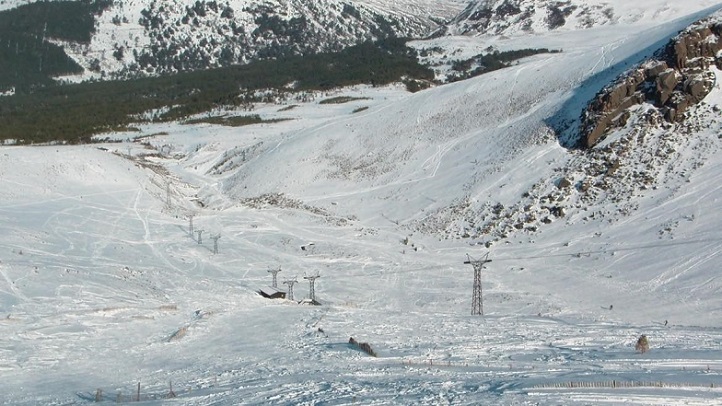
During the period following the opening of the funicular and up to May 2008, the operator tried to save money by closing down the Coire na Ciste and West Wall Chairlifts as well as the Ciste building with its attendant café. On the Cas side of the Hill, The Fiacaill T-Bar and Sheiling café were also closed down. The White Lady T-Bar was also lost after it failed due to inadequate maintenance and it was not subsequently repaired. The Aonach Poma in Coire na Ciste was removed at a later date. The management failed to realise that they were making decisions that would lead to the business being unable to trade profitably because it could no longer cope with large numbers of snowsports customers when conditions were good. It was also quite obvious that these closures led many snowsports enthusiasts to forsake Cairn Gorm.
The Case of Coire na Ciste
There was some recognition amongst the hill management that there needed to be diversification into paid for activities on the hill, if financial sustainability was ever to be realised. Accordingly, around 2010/11 there was a proposal to develop the lower part of Coire na Ciste.
Cairngorm Mountain Scotland Ltd [CMSL]were asked, via an FOI request, for copies of the relevant reports. However, the CEO, Susan Smith replied as follows on 9th January:
‘’I confirm that CMSL does not hold documentation relating to the Ciste project of 2010/11. When CMSL was incepted in December 2018 the company had to install new IT systems as the previous company [CML]’s IT system was integrated into the Natural Retreats family of companies’’
That was unhelpful. Ms Smith could have investigated whether HIE might have held the information as she would have received it all at the time when she was a Business Development Manager there. Indeed it appears that Ms Smith was instrumental in the refusal, by HIE, to support the proposed project. She’d have had all the files then, for sure.
However, I’m pleased to say that in the last few days I have managed to retrieve a number of the files from another source and I’ll be pleased to email copies of the one that are too large to publish here to Susan Smith, in due course.
Coire na Ciste chairlift: Rowema, a Swiss engineering company provided a quotation (see here) for the refurbishment of the Coire na Ciste Chairlift at a cost of around £300,000 taking into consideration the condition of the chairlift and the prevailing exchange rate, at that time.
West Wall chairlift
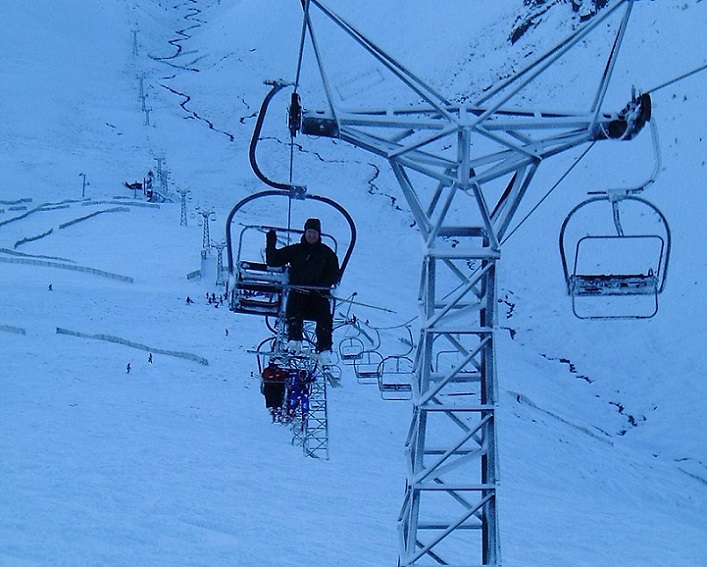
It was expected that the West Wall Chairlift would have required the same level of expenditure to bring it back into use, although a survey wasn’t done. It wasn’t part of the Adventure Area proposals although it’s use was always essential to optimise the use of the Ciste Gully as a snowsports piste. That’s because the West Wall poma is often out of use due to lack of snow on the lower part of the uptrack while the Ciste Gully is complete.
An ecological report [6MB available on request] was also commissioned from Envirocentre, a Glasgow based company. It showed that there were no rare flora or fauna within the Coire that might have prevented the proposed development.
A run of river hydro report was commissioned and subsequently provided by John Duncanson Engineering (see here). He concluded that such schemes would be possible within Coire na Ciste and Coire Cas. He calculated that tariff payments of £136,640 per annum would have accrued to the hill business and 308,000Kwh of generated power would have been available for use on the hill, considerably lowering the power bill. That was never done.
Mountain Bike Trails: The Consultants report [2 MB available on request] was produced by Tourism Resource Centre from Glasgow.
The main thrust of the development proposal was to be Mountain Bike trails with uplift via the refurbished Coire na Ciste Chairlift.
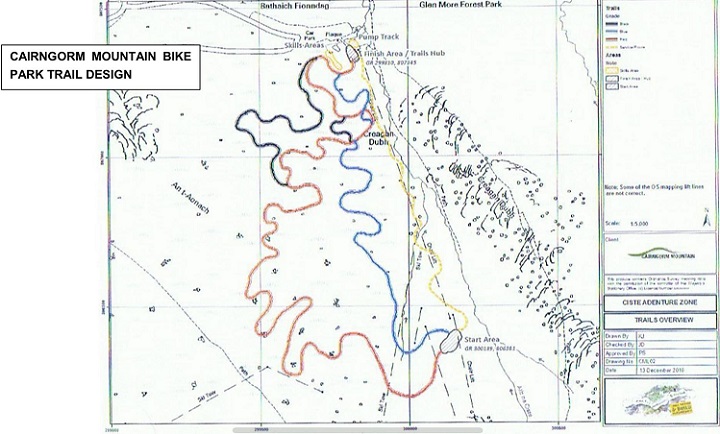
The plans show a red trail and a blue trail although the consultants recommended that there should be two blue and two red trails to provide variety and help to attract users and repeat users. A pump track outside the Ciste building was recommended where parents could watch their kids from the comfort of the cafe.
Ciste Base Station
The building would have required to be refurbished and redeveloped to put in a lift [to the upstairs café] and to incorporate toilets that were disabled friendly. A survey commissioned from Graham and Sibbald, Surveyors, in more recent years, showed the building to remain basically sound. It could still be resurrected.
A new foul water treatment plant would also have been required.
Very regrettably and much to the long-term detriment of the hill business, HIE’s business development manager, at that time, Susan Smith would not support these proposals which were then abandoned.
It does not take much imagination to see how the business could have thrived with that development. It would have been able to trade effectively throughout the period of the funicular closure from October 2018 to January 2023 [Covid lockdown excepted] and it would have considerably enhanced the campervan facility in the Ciste car park. Even in mid-January, with the ill-conceived and ill-fated funicular closed down again, snowsports enthusiasts would have had a route up the hill rather than a walk from the Daylodge to the M1 Poma which is an ‘Experts only’ surface lift. Many more day tickets would be sold than is presently the case.
HIE then doubled down on their failed strategy by demolishing the Coire na Ciste and West Wall Chairlifts in August 2017. That proved to be the most disastrous of all of their funicular centric strategies. When the funicular failed in 2018, the business had no none surface uplift that could take Skiers/Boarders and sightseers up the hill. The following winter season saw the Cairngorm Mountain share of the Scottish snowsports market collapse to an all time low level of <24% whereas it had been >40% in the 5 year period to 2013. Snowsports enthusiasts voted with their skis and boards and headed off, in the main, to Glencoe and Glenshee, where great efforts were being made to improve the product and the customer experience. Notably, the market share has not recovered because the product has not been improved.
HIE have continued with their failed strategy of squeezing everything into Coire Cas. Despite the spending of 10’s of millions of pounds of public money since 2008, there has been no improvement and that is no doubt reflected in the customer numbers. The funicular, if it ever returns to robust service, will do nothing to reverse the fortunes of the hill business. An annual subsidy would continue to be required. That’s something that is unthinkable now and will have to be abandoned. Financial stability can’t come with the present strategy so closely aligned to the funicular white elephant that is the albatross around the neck of the business.
There’s one very major flaw in the CairnGorm Mountain Scotland Ltd’s business model. The management are providing what they want to provide but that isn’t what the customers want. Continuing with the funicular centric strategy and concentrating all activities within Coire Cas has been shown to be a failure with a collapsed snowsports market share and no hint of any recovery. Until they listen to their customers and provide what they want to buy then continued failure is assured.
What needs to happen now:
- The Scottish Government need to show some leadership, step in and usher HIE off the hill
- The present Board of Directors of CMSL need to be removed along with HIE.
- The local Community, led by the Aviemore and Glenmore Community Trust, should be invited to take over and the requirements of an Asset Transfer request should be set aside until the business is stabilised and on a secure strategic path.
- The Scottish Government should require HIE to provide agreed financial guarantees, in the short and medium term.
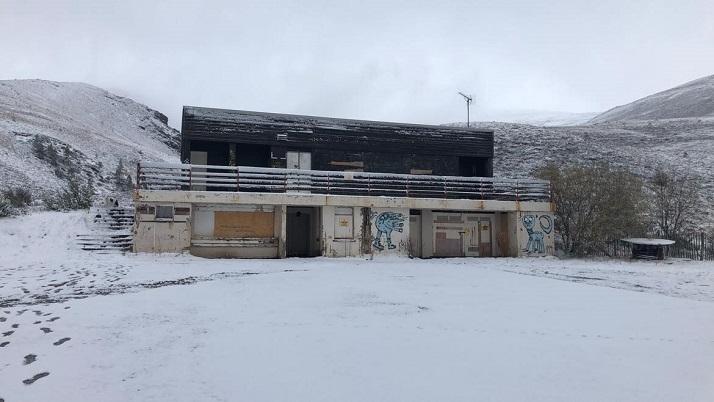

Ineptitude and mismanagement of the highest order…
And to have destroyed the Ciste apparatus in the face of a coordinated campaign to retain it, is quite simply unforgivable.
I note Ms Smith previously worked in a Business Development Manager capacity. As someone who worked in that role for many years, I would have been summarily dismissed for presiding over the wholesale destruction of my customer base. Therein lies the problem, the HIE Board simply are not living in the real world – where is the accountability for this series of disasters? Also speak volumes for the Scottish Governments and in turn their failure to manage HIE.